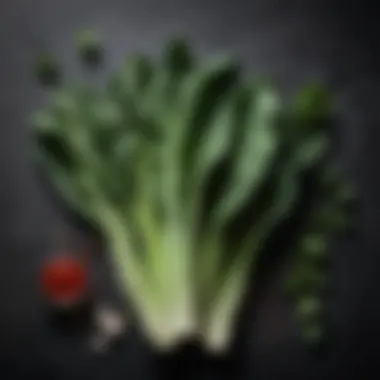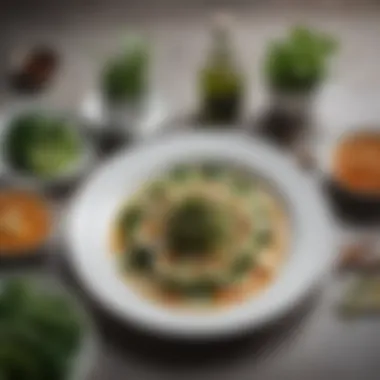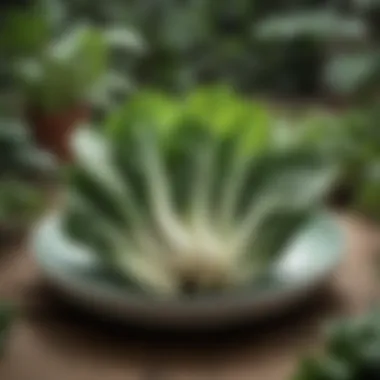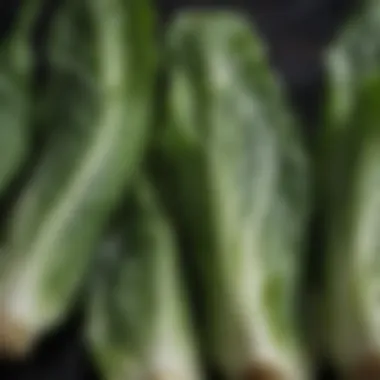Exploring Rosie Pak Choi: The Culinary Versatile Vegetable


Intro
Rosie Pak Choi, often simply referred to as Pak Choi, stands out in the realm of vegetables. Its crisp texture and subtle flavor make it a favored ingredient among chefs and home cooks alike. This leafy green, belonging to the brassica family, is known not only for its culinary versatility but also for its impressive nutritional profile.
This article will delve into various aspects of Rosie Pak Choi, providing a comprehensive glimpse into its culinary applications, health benefits, and growing techniques. Understanding this vegetable is essential for anyone looking to diversify their culinary repertoire or enhance their meals with a nutritious addition.
Through this exploration, we hope to cultivate an appreciation for Rosie Pak Choi that goes beyond its appearance or taste. We will cover its uses in different cuisines, essential nutrients it provides, and the practicalities of cultivating it at home. This information will be especially beneficial for food enthusiasts aiming to incorporate this unique vegetable into their dishes more creatively.
Prolusion to Rosie Pak Choi
The significance of Rosie Pak Choi in this article cannot be overstated. This unique vegetable, notable for its tenderness and mild flavor, plays an important role in both culinary and nutritional spheres. Understanding Rosie Pak Choi opens a window into its potential uses in various dishes, while also highlighting its health benefits and cultural background.
Rosie Pak Choi is often characterized by its smooth, dark green leaves and thick, crisp stems. It is a member of the Brassica family, which includes various familiar vegetables like broccoli and cabbage. Its versatility shines in stir-fries, salads, and even soups, making it a staple in many kitchens, particularly in Asian cuisine. The combination of its taste and nutritional value presents a case for why Rosie Pak Choi deserves more attention in contemporary cooking.
Additionally, examining the historical context of Rosie Pak Choi uncovers how this vegetable has been cultivated and appreciated over centuries. Such an exploration provides insight not only into its current popularity but also into the traditions that have shaped its culinary applications.
In summary, the introduction of Rosie Pak Choi in this article serves as a thorough exploration of its definition, characteristics, and historical significance. Understanding these facets enhances appreciation for this vegetable, encouraging its inclusion in both everyday cooking and gourmet dishes.
Nutritional Value of Rosie Pak Choi
Understanding the nutritional value of Rosie Pak Choi is crucial for anyone interested in food, health, and wellness. It provides insights into how this vegetable can enhance both culinary experiences and nutritional intake. Rosie Pak Choi is not merely a flavorful ingredient but also a powerhouse of nutrients that can contribute significantly to a balanced diet.
Vitamins and Minerals
Rosie Pak Choi is rich in essential vitamins and minerals. It contains high levels of Vitamin K, which supports bone health and proper blood clotting. Additionally, it boasts significant amounts of Vitamin C, which acts as an antioxidant and aids in immune function. Other notable vitamins present include Vitamin A, crucial for vision and skin health, and several B vitamins, including folate, which helps in DNA synthesis.
Minerals are also abundant in Rosie Pak Choi. Calcium contributes to strong bones, while potassium is important for heart health and regulating blood pressure. The presence of iron, though in smaller quantities, can support red blood cell production. Overall, Rosie Pak Choi presents a vibrant mix of nutrients that play various roles in maintaining health.
Health Benefits
The health benefits of Rosie Pak Choi are extensive and warrant attention. Eating this vegetable can promote healthy digestion, thanks to its fiber content, which aids in regular bowel movements. Furthermore, its antioxidant properties can protect against oxidative stress and inflammation, reducing the risk of chronic diseases.
Incorporating Rosie Pak Choi into meals can also support weight management. Low in calories yet high in nutrients, it makes for an excellent choice for those looking to maintain a healthy weight without sacrificing nutrition.
"Adding Rosie Pak Choi to your diet can be a simple yet effective way to enhance your overall health."
Culinary Uses of Rosie Pak Choi
The culinary uses of Rosie Pak Choi highlight its versatility and importance in various dishes. This section delves into different cooking techniques, offering insights into how they enhance the unique flavors and textures of Rosie Pak Choi. As home cooks and culinary enthusiasts experiment with this vegetable, understanding its best applications becomes paramount.
Cooking Techniques
Stir-Frying


Stir-frying is a swift and effective way to cook Rosie Pak Choi. This method allows the vegetable to retain its crispness while absorbing the flavors of the accompanying ingredients. The quick cooking time is a key characteristic, ensuring that nutritional content stays intact. Additionally, stir-frying minimizes the loss of color and texture, making dishes visually appealing.
One unique feature of stir-frying Rosie Pak Choi is its ability to pair well with various proteins like chicken, tofu, or shrimp. This adaptability makes it a popular choice for creating balanced meals. However, care must be taken to avoid overcooking, which can lead to a mushy consistency. To achieve optimal results, it's best to cook in small batches, ensuring high heat and constant movement in the pan to yield perfect stir-fried vegetables.
Steaming
Steaming is another cooking technique that benefits the integrity of Rosie Pak Choi. This method uses moist heat to cook the vegetable, preserving its delicate flavor and vibrant color. The key characteristic of steaming is that it requires no added fats, making it a healthier option for those watching their calorie intake.
A unique feature of steaming is that it enhances the vegetable's inherent sweetness. Moreover, it decreases the chance of nutrient loss compared to other cooking methods. However, the challenge lies in timing; over-steaming can result in a soft texture that may not be desirable in certain dishes. Therefore, monitoring cooking times is essential for achieving that perfect balance between tenderness and crispness.
Raw Applications
Raw applications of Rosie Pak Choi allow for the presentation of its flavor profile in its purest form. Salads featuring fresh stems and leaves maintain the crunchy texture that many find appealing. The key characteristic of utilizing Rosie Pak Choi in raw applications is the crisp bite and fresh taste it provides.
One unique feature of raw food preparation is the retained enzymes, which can enhance digestion and nutrient absorption. Incorporating Rosie Pak Choi into slaws or salads brings a nutritious crunch to the table. Though its raw flavor might be milder compared to cooked forms, some find that it lacks the depth found in other preparations. Thus, combining with bold dressings or strong spices can elevate its flavor when served raw.
Pairing with Other Ingredients
The ability to pair Rosie Pak Choi with a variety of ingredients enhances its culinary potential. The vegetable complements flavors from different cuisines, making it an ideal candidate for fusion dishes.
Some popular pairings include:
- Garlic and Ginger: These aromatics elevate the overall taste, matching well in stir-fries.
- Soy Sauce and Sesame Oil: These traditional Asian elements enhance the umami flavor, especially in cooked dishes.
- Citrus Vinaigrette: In salads, a citrus dressing can provide a refreshing contrast to the vegetable's earthy tones.
Understanding these combinations opens doors to creativity in the kitchen.
Varieties of Pak Choi
The exploration of different varieties of Pak Choi is essential in understanding the complete culinary potential of this vegetable. Each type brings unique flavors, textures, and nutritional profiles, thereby catering to diverse culinary applications. Notably, knowing these varieties can enhance your cooking experience by providing optimal choices for specific dishes or recipes. The selection of the right type can significantly influence the overall taste and presentation.
Different Types of Pak Choi
Pak Choi is a member of the Brassica family, which includes other vegetables like cabbage and broccoli. It comes in various types, each suited for different culinary needs. Here are the key types:
- Green Pak Choi: This is perhaps the most common variety. It has broad, dark green leaves and a mild flavor, making it suitable for a wide range of dishes, from stir-fries to salads.
- White Pak Choi: This type has paler green leaves with long, white stems. It tends to be slightly sweeter than the green variety and holds up well in cooking, making it perfect for braising.
- Baby Pak Choi: Smaller and tender, this variety is often used in salads and light stir-fries. Its size makes it easy to cook quickly while retaining its crisp texture.
- Rosie Pak Choi: Known for its vibrant color and tender leaves. It has a slightly peppery flavor that can add depth to various dishes, enhancing both texture and visual appeal.
The diversity in Pak Choi varieties allows chefs and home cooks alike to tailor their culinary creations based on their desired flavor profiles and textures.
Rosie Pak Choi vs. Other Varieties
When comparing Rosie Pak Choi to other varieties, several distinctions become clear. The flavor of Rosie Pak Choi is particularly appealing to those who enjoy a bit of spice in their dishes. Its peppery notes can provide a lively contrast to sweeter ingredients, creating a more complex palate experience.
Additionally, the texture of Rosie Pak Choi is another highlight. Its leaves are tender yet robust, perfect for quick cooking methods such as stir-frying or steaming. This contrasts with Baby Pak Choi, which is more delicate and can wilt quickly under heat.


Another noteworthy point is the visual aspect. Rosie Pak Choi’s vibrant color can make dishes more visually interesting. Presentation plays a significant role in food enjoyment, and the unique appearance of Rosie Pak Choi can elevate a dish’s appeal.
"Understanding the different varieties of Pak Choi opens up new avenues for creativity in the kitchen, allowing for more nuanced and enjoyable dishes."
Cultivation of Rosie Pak Choi
Cultivating Rosie Pak Choi is essential, not only for developing this versatile vegetable but also for ensuring its nutritional value and flavor remain intact. Understanding the specific needs of the plant can significantly enhance successful yields. Varieties like Rosie Pak Choi thrive in conditions that favor their growth, which includes soil composition, temperature, and sunlight. These factors play a vital role in achieving healthy, vibrant plants that can enrich culinary dishes.
Growing Conditions
For optimal growth, Rosie Pak Choi requires cool weather. Ideally, it thrives in temperatures ranging from 55°F to 75°F. Planting during early spring or fall will help in achieving desirable conditions. The soil should be well-draining and rich in organic matter, such as compost. A pH level between 6.0 and 7.5 is most suitable. It is beneficial to maintain consistent moisture levels, as this vegetable prefers not to dry out completely.
Here is a brief list of ideal growing conditions:
- Soil: Loamy, well-draining, and rich in nutrients.
- Sunlight: Full sun or partial shade is ideal.
- Temperature: Best between 55°F and 75°F.
- Watering: Keep soil consistently moist.
Pest Management
Pest management is crucial for safeguarding Rosie Pak Choi from common agricultural pests. These pests can affect the health of the plants and the quality of the harvest. Integrated pest management strategies are effective. They can include the use of natural predators, exclusion techniques, and organic pesticides when necessary. Regular monitoring of plants for early detection of pests is also essential.
Some common pests to watch out for include:
- Aphids: These small insects suck the sap from leaves, weakening plants.
- Flea Beetles: These beetles create small holes in leaves, which can affect plant growth.
- Cabbage Worms: These larvae can cause significant damage if not controlled.
Implementing strategies such as crop rotation and planting trap crops can also help mitigate pest issues.
Effective pest management not only protects the vegetable but also promotes sustainable farming practices.
Cultural Significance of Pak Choi
Pak Choi, particularly Rosie Pak Choi, holds a special place in various cultures, especially within Asian cuisine. Understanding the cultural significance of this vegetable provides valuable insights into its culinary applications and its role in traditional dishes. It is important to note that the integration of Pak Choi into meals transcends mere nutritional value; it embodies cultural practices and local flavors.
Role in Asian Cuisine
In Asian cuisine, Pak Choi is celebrated for its versatility and adaptability. It is a staple in Chinese cooking, appearing in numerous regional dishes. In the realm of stir-frying, Rosie Pak Choi stands out for its crisp texture and mild flavor, which enhances vegetable medleys and meat-based dishes.
The leafy greens are often paired with soy sauce, garlic, and ginger, bringing a depth of flavor to stir-fries. Beyond China, Pak Choi also finds a place in Korean and Japanese cuisines, used in soups and stews.
The significance of Pak Choi goes beyond its flavor; it fits into traditions of communal dining, where colorful, healthy meals are shared. The vegetable also signifies freshness and seasonality, aligning with the agricultural practices of various Asian cultures.
Traditional Dishes Featuring Rosie Pak Choi
Rosie Pak Choi features in many traditional dishes, illustrating its importance in culinary heritage. Some notable dishes include:


- Pak Choi Stir-Fry: A quick dish prepared with garlic and sesame oil, showcasing the vegetable's crispiness and flavor.
- Hot Pot: Used in this communal dish, Rosie Pak Choi absorbs the flavors of broth while maintaining its bite.
- Korean Kimchi: In certain recipes, younger Rosie Pak Choi replaces Napa cabbage, contributing a different texture to this beloved fermented dish.
The prominence of Rosie Pak Choi in these dishes signifies its adaptability across various cooking styles and preferences. Each preparation method highlights not only its unique qualities but also its cultural roots.
"The integration of Pak Choi in Asian dishes illustrates not only culinary preferences but also deep-rooted cultural practices."
Sustainability and Environmental Impact
Sustainability within modern agriculture is a critical area of focus, particularly when considering crops like Rosie Pak Choi. The environmental impact of farming practices can significantly affect not only the quality of produce but also the broader ecosystem. Rosie Pak Choi, with its adaptability, presents a unique opportunity to promote sustainable practices. The integration of eco-friendly methodologies can lead to healthier soil, enhanced biodiversity, and reduced carbon footprints.
Farmers who embrace sustainable approaches contribute to the longevity of agricultural systems, ensuring that future generations can benefit from crops like Rosie Pak Choi. The environmental challenges we face today, including climate change and loss of biodiversity, emphasize the need for a conscious shift in farming practices.
Organic Farming Practices
Organic farming focuses on using natural processes rather than synthetic inputs. This method is significant for cultivating Rosie Pak Choi because it aligns with the vegetable’s growing conditions. Organic practices prioritize soil health, biodiversity, and responsible resource use. Key elements include:
- Crop Rotation: Diversifying what is grown in a specific area helps to maintain soil nutrients and manage pests more naturally.
- Natural Fertilizers: Using compost, manure, or organic fertilizers can enrich the soil without harmful chemicals.
- Integrated Pest Management (IPM): This approach focuses on monitoring pests and using biological control methods to minimize damage, reducing reliance on pesticides.
The adoption of organic farming not only produces cleaner food but also safeguards local ecosystems, enhancing overall biodiversity.
Impact on Biodiversity
Promoting biodiversity is essential for maintaining resilient ecosystems. Rosie Pak Choi plays a versatile role in this context. When grown alongside other plant species, it can support various forms of life, including beneficial insects and microorganisms. The benefits of maintaining biodiversity include:
- Improved Soil Health: Diverse plant roots can improve soil structure and health, leading to better water retention and nutrient availability.
- Pest Control: A larger variety of plant species can attract predatory insects, reducing pest populations naturally.
- Ecosystem Resilience: Diverse ecosystems are more resistant to diseases and climate impacts, creating a more stable environment for all living organisms.
"Biodiversity is not just an environmental concern; it’s a crucial component of sustainable agriculture that can enhance food security and ecological health."
To conclude, integrating sustainable practices in the cultivation of Rosie Pak Choi can yield significant environmental benefits. Organic farming methods contribute to soil health and biodiversity, fostering ecosystems that support varied life forms. This connection highlights not only the importance of growing Rosie Pak Choi but also the responsibility of growers to adopt environmentally sound practices. Through mindful cultivation, we can appreciate and elevate this culinary icon while assuring its sustainability for future culinary enthusiasts.
Ending
In this article, we explored the multifaceted aspects of Rosie Pak Choi, an ingredient that is both nutritious and versatile in various culinary contexts. It is essential to recognize how each element discussed contributes to the appreciation of this unique vegetable.
Summary of Key Points
Rosie Pak Choi stands out for several notable reasons:
- Nutritional Profile: Packed with vitamins, minerals, and antioxidants, it contributes significantly to a healthy diet.
- Culinary Uses: With its adaptability, Rosie Pak Choi can be stir-fried, steamed, or eaten raw, making it suitable for various dishes.
- Cultural Importance: Its role in Asian cuisine underscores its value beyond mere sustenance; it connects to cultural heritage and traditional recipes.
- Sustainability Practices: From organic farming methods to its impact on biodiversity, cultivating Rosie Pak Choi aligns with environmental considerations in food production.
Overall, Rosie Pak Choi serves as a culinary icon that represents not just flavor but health and sustainability.
Future Perspectives on Rosie Pak Choi
Looking ahead, there are several promising avenues regarding Rosie Pak Choi. Increased interest in healthy eating might enhance its popularity further in the global market.
- Innovative Recipes: As chefs experiment more with plant-based ingredients, novel recipes featuring Rosie Pak Choi can emerge, broadening its appeal.
- Research on Health Benefits: Continued research may uncover additional health benefits, which could drive its demand and usage in health-focused diets.
- Sustainable Practices: As sustainability becomes a priority for many, Rosie Pak Choi's cultivation through organic and eco-friendly methods may gain more traction, encouraging farmers to adopt such practices.
This vibrant vegetable is likely to remain relevant as more people seek to elevate their culinary experiences while considering health and environmental impact.















